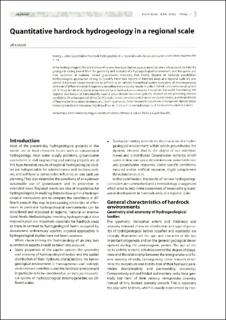| dc.description.abstract | In the hydrogeological characterisation of an area, two quantitative aspects are to be taken into account, namely the geological setting that defines the geometry and anatomy of a hydrogeological environment, and the spatial and time variations of available natural groundwater recources, that mostly depend on recharge possibilities. Methodological approaches aiming to quantify these two aspects in hardrock areas at a regional scale are presented. A hardrock environment can be defined as an intricate hierarchical system consisting of inhomogeoneous elements of different extent. A regionally prevailing transmissivity, mostly in units m 2\/d with anomalies ranging from 0.1 ,2\/d up tp 100 m2\/d, seems to be very similar in hardrock environments throughout the world. Considering this regional distribution of transmissivity, natural groundwater resources typically depend on the prevailing climatic differentation (mountains, lowlands, etc.) is of importance. Under favourable conditions in temperate climatic zones natural groundwater resources might reach up to 15 L\/s km2 in the highest parts of hardrock mountainous areas. | |

